The addition of antibiotics and arsenic to the feed promotes pig growth, but these elements can adversely affect the environment and human health through pig urine. Recently, Wu Zhengyan, a research group of the Institute of Technology and Biotechnology, Chinese Academy of Sciences, Hefei Institute of Material Science, developed a nanocomposite that can remove water or soil pollution caused by “pig emissions” and is easy to recycle. The core journal of the Royal Society of Chemistry, Environmental Science: Nano, has published the results. Veterinary Drugs
According to reports, in recent years, antibiotics and arsenic have been widely added to pig feed to improve disease resistance and promote pig growth. Studies have shown that the residues of these elements in pigs are only about 10%, within the safe range of consumption. However, about 90% of the other will be discharged into the environment, causing heavy metal pollution to water, soil and vegetation, posing a threat to human health. This problem has become one of the key bottlenecks restricting the sustainable development of the aquaculture industry.
Recently, Wu Zhengyan's research team used amine-functionalized triiron tetroxide and manganese dioxide to prepare a new type of nanocomposite, which can simultaneously remove antibiotics and arsenic in pig urine aqueous solution or soil. The material is easy to recycle after use, has high biosafety and good application prospects, and provides a new idea for dealing with heavy metal pollution in aquaculture.
Monday, October 29, 2018
China's first cross-border natural gas pipeline river bottom shield project completed
With the completion of the welding of the last weld in the Chinese territory, the welding installation of the two river bottom pipelines in the Heilongjiang Crossing Section of the Sino-Russian Eastern Gas Pipeline Project was successfully completed, 23 days ahead of the contract period. This is the first cross-border natural gas pipeline tunnel project in China. It marks the complete opening of the “throat main road” connecting the Chinese territory of China and Russia and the Russian territory, laying a solid foundation for the scheduled production of gas at the end of next year. basis.
The Heilongjiang Shield Crossing Project is the control project with the highest construction risk and the most technical difficulty in the Sino-Russian East Line project. The construction period is tight, the task is heavy, and the requirements are high. The Sino-Russian East Line Project Department of the pipeline branch cooperates with the Russian owner, SGS supervision and construction contractor to overcome the large-scale concrete pouring in the shaft and the overall prefabrication of the S-shaped pipeline in the shaft. Construction problems have effectively guaranteed the quality and safety of the construction and the progress of the construction period. The second pipe was used for 102 days, the qualification rate of welding was 96.2%, 77 days less than the first pipe welding, and the pass qualification rate of welding was increased by 3 percentage points.
It is reported that while the Chinese side speeds up construction, the construction of the Sino-Russian East-line natural gas pipeline in Russia's Siberian power pipeline has also entered the final stage. Substances Used in Analytical Chemistry
The Heilongjiang Shield Crossing Project is the control project with the highest construction risk and the most technical difficulty in the Sino-Russian East Line project. The construction period is tight, the task is heavy, and the requirements are high. The Sino-Russian East Line Project Department of the pipeline branch cooperates with the Russian owner, SGS supervision and construction contractor to overcome the large-scale concrete pouring in the shaft and the overall prefabrication of the S-shaped pipeline in the shaft. Construction problems have effectively guaranteed the quality and safety of the construction and the progress of the construction period. The second pipe was used for 102 days, the qualification rate of welding was 96.2%, 77 days less than the first pipe welding, and the pass qualification rate of welding was increased by 3 percentage points.
It is reported that while the Chinese side speeds up construction, the construction of the Sino-Russian East-line natural gas pipeline in Russia's Siberian power pipeline has also entered the final stage. Substances Used in Analytical Chemistry
In 2017, the total amount of China's biomedical industry was about 3.8 trillion
The China Life Science Park Forum hosted by the China Biotechnology Development Center was held in Beijing. During the period, the “Analysis Report on the Development Status of China Biomedical Industrial Parks in 2018” (hereinafter referred to as the “Report”) was released. According to the "Report", in recent years, the scale of China's biomedical industry has continued to grow, and the proportion of biomedical output to the pharmaceutical industry has continued to rise. In 2017, the total amount of biomedical industry in China was about 3.8 trillion yuan. The total output value of biomedicine in the surveyed park was about 1.46 trillion yuan, accounting for 38.42% of the total biomedical industry in China. Pharma Intermediates Manufacturers
It is reported that the scope of this survey mainly includes national high-tech industrial development zones and national economic and technological development zones. The online questionnaires were used to investigate the industrial status and results transfer and R&D investment and technology in the past three years. A total of 198 data on output, talent, business, products, and environment.
It is worth noting that in 2017, the total output value of the biomedical industry in the park accounted for the proportion of the total industry of the park, increasing from 16.86% in 2015 to 18.80%. In particular, the bio-pharmaceutical industry in the national high-tech zone has developed rapidly, and the proportion of the total industrial output of the national high-tech zone has increased from 19.52% in 2015 to 22.48% in 2017. Biomedicine has gradually become one of the industrial pillars of the park.
The "Report" pointed out that the development of biomedical industry, the national high-tech zone and the national economic development zone have become the core carriers of the development of China's biomedical industry. In 2017, the output value of the bio-pharmaceutical industry in the national high-tech zone and the national-level economic development zone was 1.21 trillion yuan and 0.23 trillion yuan respectively, accounting for 22.48% and 9.63% of the total industrial output of each park.
It is reported that the scope of this survey mainly includes national high-tech industrial development zones and national economic and technological development zones. The online questionnaires were used to investigate the industrial status and results transfer and R&D investment and technology in the past three years. A total of 198 data on output, talent, business, products, and environment.
It is worth noting that in 2017, the total output value of the biomedical industry in the park accounted for the proportion of the total industry of the park, increasing from 16.86% in 2015 to 18.80%. In particular, the bio-pharmaceutical industry in the national high-tech zone has developed rapidly, and the proportion of the total industrial output of the national high-tech zone has increased from 19.52% in 2015 to 22.48% in 2017. Biomedicine has gradually become one of the industrial pillars of the park.
The "Report" pointed out that the development of biomedical industry, the national high-tech zone and the national economic development zone have become the core carriers of the development of China's biomedical industry. In 2017, the output value of the bio-pharmaceutical industry in the national high-tech zone and the national-level economic development zone was 1.21 trillion yuan and 0.23 trillion yuan respectively, accounting for 22.48% and 9.63% of the total industrial output of each park.
Friday, October 26, 2018
San Diego, California or banned polystyrene plastic products
On October 15th, the City Council of California voted 5:3 to pass a ban on foam products, especially limiting the use of polystyrene plastic products in the San Diego area. But then there will be a second round of voting. Echemi Industrial Materails
The proposal plans to ban the use of products including polystyrene foam lunch boxes, cups, egg boxes, etc. Violators will be fined between US$200 and US$500 based on the number of violations within 12 months.
Opponents of the proposal believe that environmental protection actions should follow their own wishes. The mandatory ban on the use of polystyrene plastic products will greatly increase the cost of business, and will not have a major impact on chain enterprises, but for small businesses. Said that it will cause a certain impact.
The San Diego City Council has decided to impose a 12-month exemption period on small businesses with annual incomes of less than $500,000 for issues that the ban may put pressure on small businesses.
Several cities in San Diego have already approved a ban on polystyrene plastic products. If the San Diego City Council finally passes the ban, San Diego will become the largest city in California to ban the use of polystyrene plastic products.
The proposal plans to ban the use of products including polystyrene foam lunch boxes, cups, egg boxes, etc. Violators will be fined between US$200 and US$500 based on the number of violations within 12 months.
Opponents of the proposal believe that environmental protection actions should follow their own wishes. The mandatory ban on the use of polystyrene plastic products will greatly increase the cost of business, and will not have a major impact on chain enterprises, but for small businesses. Said that it will cause a certain impact.
The San Diego City Council has decided to impose a 12-month exemption period on small businesses with annual incomes of less than $500,000 for issues that the ban may put pressure on small businesses.
Several cities in San Diego have already approved a ban on polystyrene plastic products. If the San Diego City Council finally passes the ban, San Diego will become the largest city in California to ban the use of polystyrene plastic products.
Wednesday, October 10, 2018
Introducing pesticides for several biological agents
Sophora flavescens and Kushen extract - Natural Chemicals & Compounds
Matrine
It is made from the dried roots, plants and fruits of the leguminous plant Sophora flavescens by organic solvents such as ethanol. It is an alkaloid. In recent years, it has been widely used in agriculture and has good control effects. It is a low-toxic, low-residue, environmentally-friendly pesticide. It mainly controls various pests such as pine caterpillars, tea caterpillars and cabbage caterpillars. It has many functions such as insecticidal activity, bactericidal activity, and regulation of plant growth function.
Bacillus thuringiensis
Abbreviated as Bt, it is a type of Bacillus licheniformis that includes many varieties. The bacterium produces two major toxoids, endotoxin (with crystals) and exotoxin, which stop the pests from feeding, and finally the worms die from hunger and poisoning. Therefore, the bacterium can be used as a microbial low-toxic insecticide for controlling a variety of pests of Orthoptera, Coleoptera, Diptera, Hymenoptera, especially Lepidoptera.
Beauveria bassiana
It is a kind of entomopathogenic fungus with a wide range of parasitic spectrum and is a contact microbial insecticide. The control objects include corn borer, pine caterpillar, various scarabs, rice leafhopper, planthopper, mulberry, tea leafhopper, tea caterpillar, soybean borer and aphid, especially for corn borer and pine caterpillar. The means are used year after year.
Nuclear polyhedrosis virus
A group of insect viruses. This type of virus and cytoplasmic polymorphism virus can only be found on a limited number of insects. Because it has a great influence on other organisms and has a huge insecticidal power, it is also used as a biological pesticide for controlling forest pests (such as cypress leaf moth).
Biomimetic pesticide
Allicin
Allicin is a plant biomimetic pesticide, and the content of the general preparation is 80% of allicin. It uses garlic extract, which has low price and good quick-acting effect. It can quickly kill bacteria after treatment. Not only can it inhibit fungal bacteria, but it can also stimulate the growth of crops. Although it is an old medicine, it will be wonderful if it is used well. Triazole + 80% allicin, the control effect can be increased by more than 40% after mixing.
Insecticidal and insecticidal
They are all analogs of synthetic silkworm toxins. The insecticidal tablets have strong contact, stomach and systemic conduction effects, and have good control effects on larvae of lepidopteran pests. The drug is mainly used to control sugarcane. Pests on crops such as rice. Insecticidal is a nerve agent that exhibits dullness, slowness of movement, loss of ability to invade crops, cessation of development, softening of the worms, paralysis, and death after insect contact and feeding. The insecticidal double has a strong systemic action and can be absorbed and transmitted by the leaves and roots of the crop. At the same dose, the insecticidal effect is twice as high as the insecticidal double.
Matrine
It is made from the dried roots, plants and fruits of the leguminous plant Sophora flavescens by organic solvents such as ethanol. It is an alkaloid. In recent years, it has been widely used in agriculture and has good control effects. It is a low-toxic, low-residue, environmentally-friendly pesticide. It mainly controls various pests such as pine caterpillars, tea caterpillars and cabbage caterpillars. It has many functions such as insecticidal activity, bactericidal activity, and regulation of plant growth function.
Bacillus thuringiensis
Abbreviated as Bt, it is a type of Bacillus licheniformis that includes many varieties. The bacterium produces two major toxoids, endotoxin (with crystals) and exotoxin, which stop the pests from feeding, and finally the worms die from hunger and poisoning. Therefore, the bacterium can be used as a microbial low-toxic insecticide for controlling a variety of pests of Orthoptera, Coleoptera, Diptera, Hymenoptera, especially Lepidoptera.
Beauveria bassiana
It is a kind of entomopathogenic fungus with a wide range of parasitic spectrum and is a contact microbial insecticide. The control objects include corn borer, pine caterpillar, various scarabs, rice leafhopper, planthopper, mulberry, tea leafhopper, tea caterpillar, soybean borer and aphid, especially for corn borer and pine caterpillar. The means are used year after year.
Nuclear polyhedrosis virus
A group of insect viruses. This type of virus and cytoplasmic polymorphism virus can only be found on a limited number of insects. Because it has a great influence on other organisms and has a huge insecticidal power, it is also used as a biological pesticide for controlling forest pests (such as cypress leaf moth).
Biomimetic pesticide
Allicin
Allicin is a plant biomimetic pesticide, and the content of the general preparation is 80% of allicin. It uses garlic extract, which has low price and good quick-acting effect. It can quickly kill bacteria after treatment. Not only can it inhibit fungal bacteria, but it can also stimulate the growth of crops. Although it is an old medicine, it will be wonderful if it is used well. Triazole + 80% allicin, the control effect can be increased by more than 40% after mixing.
Insecticidal and insecticidal
They are all analogs of synthetic silkworm toxins. The insecticidal tablets have strong contact, stomach and systemic conduction effects, and have good control effects on larvae of lepidopteran pests. The drug is mainly used to control sugarcane. Pests on crops such as rice. Insecticidal is a nerve agent that exhibits dullness, slowness of movement, loss of ability to invade crops, cessation of development, softening of the worms, paralysis, and death after insect contact and feeding. The insecticidal double has a strong systemic action and can be absorbed and transmitted by the leaves and roots of the crop. At the same dose, the insecticidal effect is twice as high as the insecticidal double.
Sunday, May 6, 2018
Reducing Tax Burden on Enterprises Has Given Obvious Boost to Economy
The value added tax for manufacturing was lowered from 17 to 16 percent on Tuesday, while the rate for transportation, construction, basic telecommunication services and farm produce was reduced from 11 to 10 percent. The government also unified the standard for small-scale taxpayers and returned the withholdings of value added tax of some industries. Beijing News commented on Wednesday:
The tax cuts have generated immediate effects. The price of gasoline and diesel dropped by 75 yuan ($12) per ton and 65 yuan per ton respectively, and the prices of some automobiles dropped by tens of thousands of yuan.
The tax cuts will amount to 400 billion yuan ($64 billion) this year. This will not only directly benefit enterprises, it will also have a chain reaction that will boost consumption growth.
Reducing the tax burden on enterprises is an important goal of the government this year, as it targets a crucial problem hindering the development of enterprises.
It should be regarded as part of the supply-side structural reform to boost production and drive up consumption's share in the economy.
Supply-side structural reforms have harvested obvious effects. Data from the National Bureau of Statistics show that the total retail sales of consumer goods hit 36.6 trillion yuan last year, up 10.2 percent from 2016. This is the 14th year that it has grown at a double-digit speed.
Consumption plays a fundamental role in driving economic growth. The robust growth of consumption will promote the restructuring of the national economy, and boost the development of the service sectors. Echemi Promotion
Chemical price increase letter keeps coming
Zhanxin
At the United States Coatings Show for the first time in a brilliant debut of Zhanxin due to various reasons announced from May 1, Europe, the Middle East and Africa, all amino resin prices rise; the same time, powder coating resin products arrival prices. The price of indoor products/outdoor products/super weather-resistant products was increased by RMB 400/t. The price of ADDITOL products remained unchanged. Weekly Price on Echemi.com
Gongga Snow
Under the heavy pressure of the downstream application market, and domestic and provincial environmental supervision, the Sichuan Gongga Snow New Material Co., Ltd. recently issued a notice to raise the price of the Gonggaxue series of products. From May 1, the price of the "Gong Gong Xue" calcium carbonate series will be raised. The price of coarse products was raised by RMB 20/ton for 400 mesh, and RMB 30/ton for fine products.
Clariant
Clariant, a leading global manufacturer of specialty chemicals, recently announced that it will implement global price increases for most of its pigments and dyes, which will be 5% to 20%, due to sustained price increases of major raw materials, and in 2018 Effective on May 1 or according to the terms of the contract.
The continuous rise in raw material prices will also drive price fluctuations in the downstream chemical market.
At the United States Coatings Show for the first time in a brilliant debut of Zhanxin due to various reasons announced from May 1, Europe, the Middle East and Africa, all amino resin prices rise; the same time, powder coating resin products arrival prices. The price of indoor products/outdoor products/super weather-resistant products was increased by RMB 400/t. The price of ADDITOL products remained unchanged. Weekly Price on Echemi.com
Gongga Snow
Under the heavy pressure of the downstream application market, and domestic and provincial environmental supervision, the Sichuan Gongga Snow New Material Co., Ltd. recently issued a notice to raise the price of the Gonggaxue series of products. From May 1, the price of the "Gong Gong Xue" calcium carbonate series will be raised. The price of coarse products was raised by RMB 20/ton for 400 mesh, and RMB 30/ton for fine products.
Clariant
Clariant, a leading global manufacturer of specialty chemicals, recently announced that it will implement global price increases for most of its pigments and dyes, which will be 5% to 20%, due to sustained price increases of major raw materials, and in 2018 Effective on May 1 or according to the terms of the contract.
The continuous rise in raw material prices will also drive price fluctuations in the downstream chemical market.
Chinese Acetone Market Fluctuated Up in Apr 2018
In April 2018, the Chinese acetone market fluctuated up. The overall trading was modest. Up to April 30, 2018, reference negotiation prices for acetone in Jiangsu and Zhejiang were around RMB 5,650/mt, up RMB 525/mt or 10.24% month on month. The average price was RMB 5,510/mt, increasing RMB 240/mt or 4.55% month on month. Echemi Mall
In H1 April, propylene prices moved up. Few acetone producers raised prices. Chinese acetone producers increased prices by RMB 300/mt. Holders in the Chinese market were unwilling to sell goods at low prices. Mainstream prices inched up. In H2 April, the Chinese acetone market prices became stable. Phenolic ketone units at Sinopec Beijing Yanshan Company were shut and the phenol unit at Formosa Industries (Ningbo) continue to be shut. The phenolic ketone unit at Lihuayi was shut for 3 days. The supply in the Chinese market declined. The inventory at ports was less than 20kt. Producers were bullish about the market while the demand was tepid. The overall trading was weak.
In H1 April, propylene prices moved up. Few acetone producers raised prices. Chinese acetone producers increased prices by RMB 300/mt. Holders in the Chinese market were unwilling to sell goods at low prices. Mainstream prices inched up. In H2 April, the Chinese acetone market prices became stable. Phenolic ketone units at Sinopec Beijing Yanshan Company were shut and the phenol unit at Formosa Industries (Ningbo) continue to be shut. The phenolic ketone unit at Lihuayi was shut for 3 days. The supply in the Chinese market declined. The inventory at ports was less than 20kt. Producers were bullish about the market while the demand was tepid. The overall trading was weak.
Saturday, April 28, 2018
Chinese Isopropanol Market Moved Up This Week
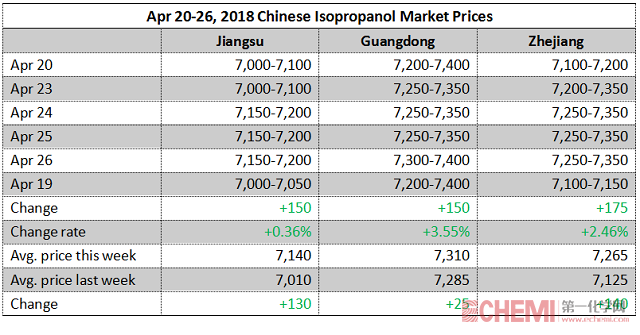
The Chinese isopropanol market fluctuated up this week. Up to April 26, 2018, the closing prices for isopropanol in Jiangsu were in the range of RMB 7,150-7,200/mt, up RMB 150/mt or 2.13% week on week. The supply was tight and isopropanol producers held firm offers. Some traders were reluctant to sell goods at low prices. Moreover, acetone prices moved up, which supported the isopropanol market. Market prices continued moving up, and the mainstream negotiation prices followed the uptrend. The downstream demand remained flat. chemical solvents
Chinese Titanium Dioxide Market Moved Marginally This Week
The Chinese rutile titanium dioxide market remained largely stable. Up to april 26, 2018, mainstream negotiation prices for rutile titanium dioxide were in the range of RMB 15,700-18,000/mt. The average price was RMB 16,700/mt, unchanged from last week. Producers’ offers were stable and the overall operating rate was largely stable. List of titanium dioxide
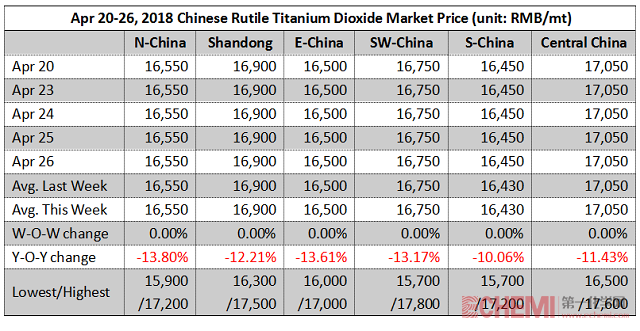
The Chinese anatase titanium dioxide market remained stable this week. Up to April 26, 2018, mainstream negotiation prices for anatase titanium dioxide were in the range of RMB 13,200-14,800/mt. The average price was RMB 14,042/mt. The operating rate was stable. The overall trading was cautious.
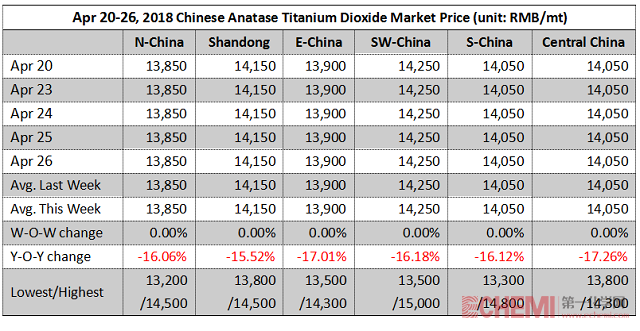
Forecast:
The supply and demand in the Chinese rutile titanium dioxide market will be stable. Raw materials prices will move weakly and the downstream demand for titanium dioxide will be flat. It is predicted that the Chinese titanium dioxide market will continue to move marginally.
Chinese Cyclohexanone Market Saw Thin Tradings This Week
Market Review: The Chinese cyclohexanone market moved firmly this week. Benzene prices moved marginally at lows, and the support to cyclohexanone producers was weak. Some units were shut and the inventory was consumed to a low level. Producers’ sentiments were fairish. Traders operated flexibly. Up to April 26, 2018, prices for cyclohexanone in Shandong were in the range of RMB 11,500-11,700/mt, up RMB 80/mt. Prices for cyclohexanone in East China were in the range of RMB 11,800-12,000/mt, up RMB 80/mt.
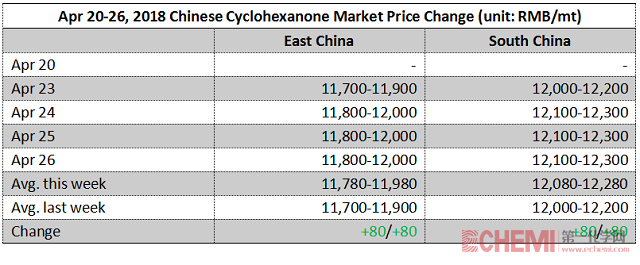
Forecast: The benzene market will continue to move marginally in the short term. The support to the cyxlohexanone market is not ample. Producers will hold firm offers in the short term. However, the downstream demand will continue to be weak, especially in the chemical fiber market. It is predicted that the cyclohexanone market will continue to move weakly in the short term.
List of cyclohexanone: https://www.echemi.com/searchGoods/pid_Seven3075-cyclohexanone.html
Tuesday, April 17, 2018
New Fluorescent Dyes Could Advance Biological Imaging
With a new technique to craft a spectrum of glowing dyes, chemists are no longer chasing rainbows. Pigment Suppliers
Swapping out specific chemical building blocks in fluorescent molecules called rhodamines can generate nearly any color scientists desire—ROYGBIV and beyond, researchers report September 4, 2017 in the journal Nature Methods.
The work offers scientists a way to adjust the properties of existing dyes deliberately, making them bolder, brighter, and more cell-permeable too. Such an expanded palette of dyes could help researchers better illuminate the inner workings of cells, says study leader Luke Lavis, a group leader at the Howard Hughes Medical Institute's Janelia Research Campus in Ashburn, Virginia. His team lit up cell nuclei, made larval fruit fly brains shine, and highlighted visual cortex neurons in mice that had tiny glass windows fitted into their skulls.
Scientists used to concoct different dyes mostly by trial and error, Lavis says. "Now, we've figured out the rules, and we can make almost any color." His team's method could allow chemists to synthesize hundreds of different colors.
A bright history
Until about 20 years ago, scientists relied on chemical fluorescent dyes to make biological molecules visible. For peeking inside cells, staining organelles, and other imaging experiments, "chemistry was king," Lavis wrote in a July 13, 2017 perspective in the journal Biochemistry. And then, the king was kicked off the throne—by a glowing green jellyfish protein called GFP.
In 1994, scientists reported the use of a genetic trick to tack GFP, the green fluorescent protein, onto other cellular proteins; it's like forcing the proteins to hold a glow stick. That trick gave researchers a simpler way to trace proteins' movements under a microscope—without using expensive synthetic dyes. The innovation blazed through the field of biological imaging. In 2007, scientists' mixing of GFP and two other fluorescent proteins let them paint mouse neurons a parade of vivid colors in a technique known as the "Brainbow." A year later, the discovery and development of GFP earned the Nobel Prize in chemistry for three scientists, including the late Roger Tsien, an HHMI investigator.
But GFP has some dark sides too. It's a relatively clunky molecule built out of the limited set of natural amino acids. So GFP isn't always bright enough to reveal what scientists are trying to see.
So researchers turned back to chemistry. Scientists had developed cutting-edge microscopes and new techniques to label cellular contents, Lavis says, but the dyes for marking molecules inside cells were still stuck in the nineteenth century. His team focused on rhodamines, because they're especially bright and cell-permeable—so they easily slip into cells and make them glow. But despite working with rhodamines for more than 100 years, chemists had created only a few dozen colors, and most were similar shades ranging from green to orange.
Swapping out specific chemical building blocks in fluorescent molecules called rhodamines can generate nearly any color scientists desire—ROYGBIV and beyond, researchers report September 4, 2017 in the journal Nature Methods.
The work offers scientists a way to adjust the properties of existing dyes deliberately, making them bolder, brighter, and more cell-permeable too. Such an expanded palette of dyes could help researchers better illuminate the inner workings of cells, says study leader Luke Lavis, a group leader at the Howard Hughes Medical Institute's Janelia Research Campus in Ashburn, Virginia. His team lit up cell nuclei, made larval fruit fly brains shine, and highlighted visual cortex neurons in mice that had tiny glass windows fitted into their skulls.
Scientists used to concoct different dyes mostly by trial and error, Lavis says. "Now, we've figured out the rules, and we can make almost any color." His team's method could allow chemists to synthesize hundreds of different colors.
A bright history
Until about 20 years ago, scientists relied on chemical fluorescent dyes to make biological molecules visible. For peeking inside cells, staining organelles, and other imaging experiments, "chemistry was king," Lavis wrote in a July 13, 2017 perspective in the journal Biochemistry. And then, the king was kicked off the throne—by a glowing green jellyfish protein called GFP.
In 1994, scientists reported the use of a genetic trick to tack GFP, the green fluorescent protein, onto other cellular proteins; it's like forcing the proteins to hold a glow stick. That trick gave researchers a simpler way to trace proteins' movements under a microscope—without using expensive synthetic dyes. The innovation blazed through the field of biological imaging. In 2007, scientists' mixing of GFP and two other fluorescent proteins let them paint mouse neurons a parade of vivid colors in a technique known as the "Brainbow." A year later, the discovery and development of GFP earned the Nobel Prize in chemistry for three scientists, including the late Roger Tsien, an HHMI investigator.
But GFP has some dark sides too. It's a relatively clunky molecule built out of the limited set of natural amino acids. So GFP isn't always bright enough to reveal what scientists are trying to see.
So researchers turned back to chemistry. Scientists had developed cutting-edge microscopes and new techniques to label cellular contents, Lavis says, but the dyes for marking molecules inside cells were still stuck in the nineteenth century. His team focused on rhodamines, because they're especially bright and cell-permeable—so they easily slip into cells and make them glow. But despite working with rhodamines for more than 100 years, chemists had created only a few dozen colors, and most were similar shades ranging from green to orange.
Researchers Discover an Evolutionary Stepping Stone to Beet-Red Beets
For 100 years, the food industry has resolved consumers’ competing demands for processed, shelf-stable foods with fresh-looking colors by relying on synthetic colorants. On an ingredient label, these dyes appear as Blue 1, Red 40, Yellow 5, and others. Dye Intermediates
However, consumers have become increasingly concerned about the potential negative health effects of such synthetics. For example, the synthetic dye Red 2 was identified as a carcinogen by the FDA in the 1970s and taken off the market—the ensuing consumer fear of red dyes in general led candy companies to eliminate red from their products for more than a decade. The FDA determined that another dye, Red 3, contributed to skin cancer, and they banned it in products used on the skin, though it remains legal for use in foods.
The food industry’s use of natural pigments has been hampered by these ingredients’ degradation during many common food processing techniques: Beet root extract, for example, is already used extensively in beverages, dairy, and fruit products, but its color degrades when exposed to heat, light, or changes in pH.
The new technique developed by Cornell food scientists uses the state-of-the-art Hiperbaric high-pressure processing unit at Cornell’s New York State Agricultural Experiment Station in Geneva. Normally the unit—which subjects foods to pressure up to 87,000 pounds per square inch—is used in place of heated processing to kill bacteria in fresh foods. But Abbaspourrad, Padilla-Zakour and their colleagues discovered that it can also be used to assimilate and stabilize colorant.
“When you take beet juice, formulate it with hydrocolloids and apply high pressure, it actually affects the way these complexes are formed and creates a stable color, which you can’t obtain by common techniques,” Abbaspourrad said.
In contrast to some synthetic dyes, beet juice is decidedly healthy. It has been found to have anti-cancer, antioxidant, anti-inflammatory, and neuroprotective properties.
However, consumers have become increasingly concerned about the potential negative health effects of such synthetics. For example, the synthetic dye Red 2 was identified as a carcinogen by the FDA in the 1970s and taken off the market—the ensuing consumer fear of red dyes in general led candy companies to eliminate red from their products for more than a decade. The FDA determined that another dye, Red 3, contributed to skin cancer, and they banned it in products used on the skin, though it remains legal for use in foods.
The food industry’s use of natural pigments has been hampered by these ingredients’ degradation during many common food processing techniques: Beet root extract, for example, is already used extensively in beverages, dairy, and fruit products, but its color degrades when exposed to heat, light, or changes in pH.
The new technique developed by Cornell food scientists uses the state-of-the-art Hiperbaric high-pressure processing unit at Cornell’s New York State Agricultural Experiment Station in Geneva. Normally the unit—which subjects foods to pressure up to 87,000 pounds per square inch—is used in place of heated processing to kill bacteria in fresh foods. But Abbaspourrad, Padilla-Zakour and their colleagues discovered that it can also be used to assimilate and stabilize colorant.
“When you take beet juice, formulate it with hydrocolloids and apply high pressure, it actually affects the way these complexes are formed and creates a stable color, which you can’t obtain by common techniques,” Abbaspourrad said.
In contrast to some synthetic dyes, beet juice is decidedly healthy. It has been found to have anti-cancer, antioxidant, anti-inflammatory, and neuroprotective properties.
Coloring That Can't Be Beet: New Food Process Replaces Synthetic Dyes
Consumers are fickle creatures: We want to have our red-hued strawberry cake and eat it two weeks later. But the natural colorants that give fresh foods a pleasing color can degrade dramatically when exposed to common food processing techniques. This has led manufacturers to rely on synthetic dyes, to consumers’ increasing displeasure. Dyes and Pigments Chemicals
Now, a team of Cornell University food scientists has discovered a way to process natural beet juice so that it maintains its bright red color and will allow food manufacturers to use it in place of synthetic dyes in a much greater variety of foods.
Combining beet root extract with locust bean gum, sodium alginate, or gum arabic and then subjecting it to very high pressure improves the stability of red colorant during heated food processing, as well as during up to six weeks of cold storage, according to a recent paper.
“Our goal is to provide clean ways of modifying ingredients, using chemistry knowledge and technology that we develop in the lab, to help the food industry create healthier, more palatable foods,” said lead author Alireza Abbaspourrad, the Youngkeun Joh Assistant Professor of Food Chemistry and Ingredient Technology in the Department of Food Science. “We’re looking at how we can use natural ingredients, stabilize them, make them last longer, and incorporate them in our diets.”
Abbaspourrad and co-author Olga Padilla-Zakour, professor and chair of the Department of Food Science, along with postdoctoral researchers Michael Joseph Selig, Giovana Bonat Celli, and Chen Tan, filed a provisional patent for the new processing technique through Cornell’s Center for Technology Licensing.
Now, a team of Cornell University food scientists has discovered a way to process natural beet juice so that it maintains its bright red color and will allow food manufacturers to use it in place of synthetic dyes in a much greater variety of foods.
Combining beet root extract with locust bean gum, sodium alginate, or gum arabic and then subjecting it to very high pressure improves the stability of red colorant during heated food processing, as well as during up to six weeks of cold storage, according to a recent paper.
“Our goal is to provide clean ways of modifying ingredients, using chemistry knowledge and technology that we develop in the lab, to help the food industry create healthier, more palatable foods,” said lead author Alireza Abbaspourrad, the Youngkeun Joh Assistant Professor of Food Chemistry and Ingredient Technology in the Department of Food Science. “We’re looking at how we can use natural ingredients, stabilize them, make them last longer, and incorporate them in our diets.”
Abbaspourrad and co-author Olga Padilla-Zakour, professor and chair of the Department of Food Science, along with postdoctoral researchers Michael Joseph Selig, Giovana Bonat Celli, and Chen Tan, filed a provisional patent for the new processing technique through Cornell’s Center for Technology Licensing.
Tuesday, April 10, 2018
CPhi Japan to See Increased Participation of International Generic API Firms
The 2018 edition of CPhI Japan expo is set to witness increased participation of international generic API companies and suppliers even though the market is regarded as an innovative drug focussed one. This is because, as revealed in the CPhI Japan 2018 report, after years of gradual reforms, the Japanese pharma economy is becoming extremely welcoming for generics and overseas manufacturers – particularly those that can combine exemplary regulatory records with competitive pricing. By joining the Pharmaceutical Convention Inspection (PIC/S) scheme in 2014, Japan has opened its doors to new entrants.
The pharma exhibition will take place at the Big Sight Exhibition Centre, Tokyo, Japan from 18-20 April, 2018. CPhI Japan features companies working across ingredients, contract services, biopharmaceuticals, machinery, technology, and packaging. The event will also feature a finished dosage formulation zone (FDF) for 2018, building on the increasing diversity of the API supplier base.
Over 21,000 visitors from 56 countries and 550 exhibitors from 30 countries are expected to participate in the event highlighting the country’s growing internationalisation.
The CPhI Japan conference will feature insights from the Ministry of Health, Labour and Welfare (MHLW), the Pharmaceuticals and Medical Devices Agency, the Japanese Society of Generic and Biosimilar Medicines, and the Japan Pharmaceutical Traders’ Association. Another major development in Japan, especially for new market entrants, is the implications of the 2018 ‘Pricing system reform and introduction of cost-effectiveness assessment’ on which the conference will host a keynote address. Conversely, for buyers in the region, information and access to the international partners will be integral to establishing a robust supply chain, with the event also hosting an ‘International API Procurement Forum’ – specifically designed to empower the Government’s requirement for 80% generic market penetration by 2020.
pharmaceutical chemicals“CPhI Japan is an accurate bellwether of the wider market trends in the country, and this year we are seeing an acceleration of interest in generics and biologicals, particularly biosimilars – which the market has been previously resilient towards. But there is also more generally increased international interest and investment in all product classes –including innovative medicine – thanks to deregulation and streamlined new drug approval processes,” commented Ms. Laura Murina, Brand Manager, CPhI Japan at UBM.
China to Impose 25% Tariffs on Plastic Products from U.S.
The Ministry of Commerce of China has announced that it will impose 25% tariffs on imports of agricultural products, automobiles, chemicals and aircraft from the U.S. Final measures and effective time will be announced separately. By marshalling the list, the related plastic products are LDPE, PVC, PC, POE, BOPET, PE wrapping film and adhesive tape jumbo roll.
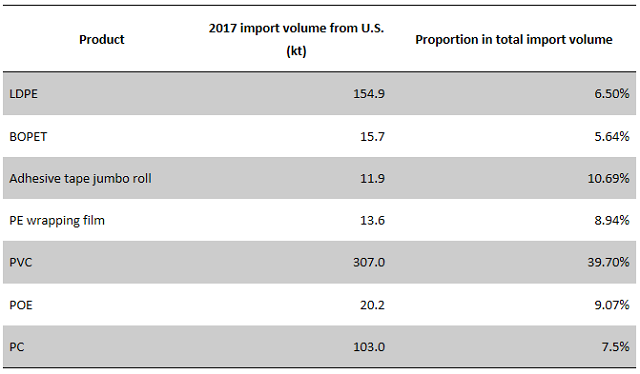
BOPET, PE wrapping film and adhesive tape jumbo roll are the downstream products. The supply of these products is ample in China, and the import volume from U.S. is small. Thus the impact of 25% tariffs on these products will be small.
LDPE, PC, PVC and POE are upstream materials. Although POE is totally dependents on imports in China, the major import origins are Thailand, Singapore and South Korea. The import volume from the U.S. is small and unstable. Thus the influence of tariff on POE will be small.
China imported 307kt of PVC from the U.S. in 2017, taking up 39.7% of the total PVC import volume. However, China has imposed anti-dumping duties on PVC from the U.S. for many years. Most imported PVC from the U.S. is via the trade mode of processing trade with imported materials and processing and assembling trade provided with raw materials. Thus the influence of tariff on PVC will be small.
At present, the LDPE resources from the U.S. have strong price advantages. The trade mode is mainly general trade. After imposing 25% tariffs, the prices of imported LDPE from the U.S. will exceed the mainstream LDPE prices in China obviously. It is estimated that the traders will stop trading with the U.S. LDPE producers in the future. China imported 154.9kt of LDPE from the U.S. in 2017. However, the U.S. is not the largest import origin. The largest import origins are Iran, Saudi Arabia, UAE, Qatar and South Korea.
Chloroacetic Acid Market: Exporters Should Be Cautious
In February 2018, the export volume of Chinese chloroacetic acid List shrank to 1,558.66/mt, down 37.25% month on month. Unstable prices in the Chinese market influenced the negotiation sentiments in trading.
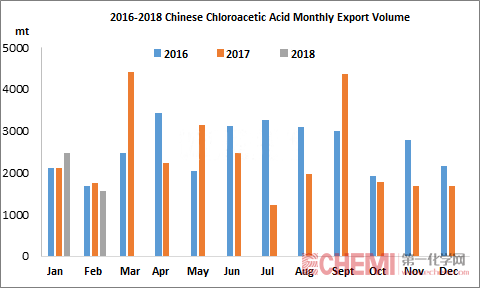
In February 2018, the export volume of chloroacetic acid was 1,558.66mt, down 37.25% month on month and down 10.88% year on year. The average export price was $964.08%, being equivalent to RMB 6,555/mt. The overall trading in the Chinese chloroacetic acid market was not active influenced by the Spring Festival holiday. Mainstream prices moved down obviously. Exporters saw high profits. buy Chloroaceticacid - Industrial Grade
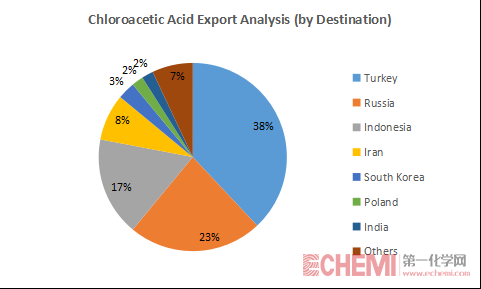
Russia and Turkey are the major export destination of China’s chloroacetic acid.
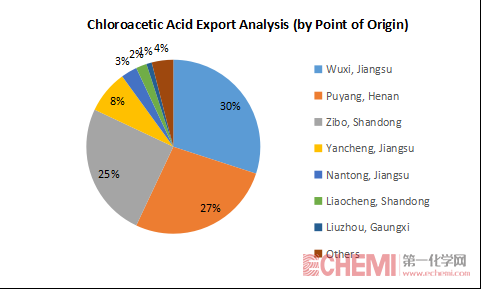
As for the producers, Shandong Minji was still the major exporter. Moreover, the proportion of exported goods from Henan and Jiangsu increased.
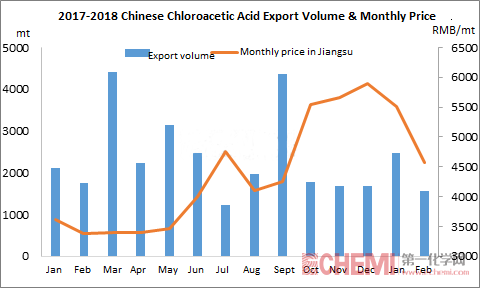
Restricted by the high prices, foreign users purchased chloroacetic acid cautiously. Pesticide Intermediates Meanwhile, the production cost was high and many Chinese chloroacetic acid producers may face losses. Chinese exporters won’t make long-term orders without careful consideration. It is predicted that the export volume in March and April will decline.
Sunday, April 8, 2018
March is passed, can REACH Registration dossiers still be submitted?
The deadline for
the 1-100 tonne chemical substance REACH (Annex VII / VIII) is May 31, 2018.
Related companies need to submit registration dossiers before this date so that
their substances can continue to be produced and imported into the EU market.
The main registrant should submit the main file by the end of March 2018 so that
other SIEF members have sufficient time to submit their files by May 31, 2018.
REACH requires
registrants to make every effort to agree on data sharing and joint submission.
But if the negotiation fails, you can file a dispute with ECHA. ECHA will
evaluate your case and see if you and your peers are doing their best to reach
a fair, transparent and non-discriminatory agreement.
If you have
recently filed a dispute with ECHA and your dispute is still pending on May 31
(ie, the deadline for registering small quantities of chemicals), this means
that you cannot successfully submit your file before the deadline. REACH
registration is completed before the deadline. REACH Search
If you happen to
be in this situation, ECHA will contact you by May 31st and provide
instructions on how to submit your application so that you can continue
business operations until the dispute is finally decided.
If the final
dispute decision is in your favor, ECHA will inform you that it can complete
the submission. If the final dispute is unfavorable to you, ECHA will reject
your application. You must succeed in submitting a new registration dossier
before you can continue to produce or import more than one ton per year into
the EU market.
OCP Group in Morocco May Become the World's Largest Fertilizer Exporter in 2018
The Jorf Fertilizers Company 3 (JFC 3), the third comprehensive fertilizer production plant of the OCP Group in Morocco, invested 5.2 billion dirhams and is now fully operational on the Jorf Lasfar industrial platform. It is reported that the plant will strengthen the production capacity of OCP Group and it is expected that the Group will become the world's largest exporter of chemical fertilizers in 2018. Agrochemicals on Echemi.com
OCP Group in Morocco May Become the World's Largest Fertilizer Exporter in 2018
Founded in March 2017, the JFC 3 unit reached its rated capacity in October. The production capacity of the fertilizer plant is set at 1 million tons per year, which will significantly increase the overall production capacity of the OCP Group. With the commissioning of JFC 4, it is expected that the total capacity will reach 12 million tons in 2018.
Specifically, JFC 3 also includes a sulphuric acid production line with an annual output of 1.4 million tons and a phosphoric acid production line with an annual output of 450,000 tons. The chemical reactions that produce these acids are exothermic reactions. For optimization, the released heat is recovered to a thermoelectric power plant with a power of 62 MW, which makes JFC 3 fully autonomous in terms of energy consumption.
In addition, JFC 3 has a storage facility with a capacity of 200,000 tons of fertilizer, equivalent to more than two months of reserves.
In response, JFC 3 director Ahmed Mahrou stated that the experience and skills of OCP Group over the years, as well as the progress made in designing production units, have enabled this new plant to achieve “the Group’s best environmental performance and reduce SO 2 in sulfuric acid reactors. (Sulfur dioxide) content, treatment of wastewater before discharge, and reduction of fluoride discharge into the sea.
"Incorporating a number of technological innovations, JFC 3 has strengthened the OCP Group's international strategic positioning while meeting the needs of foreign customers," said Ahmed Mahrou. "The group conducts major green investment each year, especially to promote water resources and energy economy. Reducing the environmental impact of their activities in the value chain."
The China-Africa Trade Research Center analyzed that, with the commissioning of the JFC 3 production plant, Morocco's OCP Group will become the world's largest exporter of chemical fertilizers in 2018, with an annual production capacity of 12 million tons. This will not only consolidate the OCP Group's international status in the global fertilizer production chain, but also corroborate Morocco as a veritable “phosphate kingdom”.
OCP Group in Morocco May Become the World's Largest Fertilizer Exporter in 2018
Founded in March 2017, the JFC 3 unit reached its rated capacity in October. The production capacity of the fertilizer plant is set at 1 million tons per year, which will significantly increase the overall production capacity of the OCP Group. With the commissioning of JFC 4, it is expected that the total capacity will reach 12 million tons in 2018.
Specifically, JFC 3 also includes a sulphuric acid production line with an annual output of 1.4 million tons and a phosphoric acid production line with an annual output of 450,000 tons. The chemical reactions that produce these acids are exothermic reactions. For optimization, the released heat is recovered to a thermoelectric power plant with a power of 62 MW, which makes JFC 3 fully autonomous in terms of energy consumption.
In addition, JFC 3 has a storage facility with a capacity of 200,000 tons of fertilizer, equivalent to more than two months of reserves.
In response, JFC 3 director Ahmed Mahrou stated that the experience and skills of OCP Group over the years, as well as the progress made in designing production units, have enabled this new plant to achieve “the Group’s best environmental performance and reduce SO 2 in sulfuric acid reactors. (Sulfur dioxide) content, treatment of wastewater before discharge, and reduction of fluoride discharge into the sea.
"Incorporating a number of technological innovations, JFC 3 has strengthened the OCP Group's international strategic positioning while meeting the needs of foreign customers," said Ahmed Mahrou. "The group conducts major green investment each year, especially to promote water resources and energy economy. Reducing the environmental impact of their activities in the value chain."
The China-Africa Trade Research Center analyzed that, with the commissioning of the JFC 3 production plant, Morocco's OCP Group will become the world's largest exporter of chemical fertilizers in 2018, with an annual production capacity of 12 million tons. This will not only consolidate the OCP Group's international status in the global fertilizer production chain, but also corroborate Morocco as a veritable “phosphate kingdom”.
Which country in Europe will be the most troubled guest? Authoritative statistics come!
This data refers to the “2017 European Payment Report” prepared by Swedish collection agency Intrum Justitia AB (the largest debtor in Europe). Help You Get More Trust & Opportunities in EU Chemical Market
The report pointed out that the solvency of Greece, Portugal, Spain, Italy, and Ireland can be said to be the worst in Europe. The average number of days of payment between Greek companies exceeds 2 months, reaching 63 days, and the general contract requires 49 days. This is also one of the longest paid records in European countries. Among the 29 member states of the European Union, only Portugal exceeds Greece for 68 days. REACH Search
The following is a list of the European Union's contractual B2B contract reimbursement period and how long it takes for the recipient to actually receive the money.
Greece
The average number of payment days for B2B transactions was 63 days. In addition, the number of days that Greek government agencies paid suppliers was even more on average 103 days. In 2016, the “champion” was Italy, 131 days.
Portugal
The average number of payment days for B2B transactions is 66 days.
Spain
The average number of payment days for B2B transactions is 55 days.
Italy
The average number of payment days for B2B transactions is 52 days.
Ireland
The average number of payment days for B2B transactions is 50 days.
France
The average number of payment days for B2B transactions is 46 days.
Netherlands
The average number of payment days for B2B transactions is 32 days.
United Kingdom
The average number of payment days for B2B transactions is 26 days.
Germany
The average number of payment days for B2B transactions is 19 days.
In terms of repayment risk, Portugal, Greece, Italy, and Iceland have the highest risk, and the Czech Republic, the United Kingdom, and Croatia are also on the list.
In addition, Justinia’s CEO Eriksson pointed out that the most disturbing finding was that low interest rates have lost their usefulness. Only 13% of respondents said that low borrowing costs prompted them to increase their investment while 81% of respondents The company said no effect.
This means that the cash flow of European companies is rapidly declining, which leads to a sudden increase in accounts receivable and overdue payments. In addition, although low interest rates no longer have an impetus for companies, interest rate increases will certainly have an adverse effect on them, further exacerbating this disturbing trend. Unless problems are repaired immediately, a large number of companies will default. Echemi.com
Tuesday, April 3, 2018
US Ethanol Exports Would Take Major Hit from China's Tariff Threat
China's proposed 45 percent tariff on US ethanol imports would block an estimated 20 million gallons/month of shipments, deal a blow to US producers' export ambitions and make China's own E10 target unreachable, according to S&P Global Platts Analytics. quality Fertilizer on Echemi
US ethanol exports to China have been on the rise in recent months, despite an existing 30 percent tariff imposed in January 2017.Proposed 45 percent tariff could block 20 million gallons/month Drop in US imports would make China's E10 target impossible US ethanol group urges White House to expand domestic demand.
China proposed adding an additional 15 percent tariff in retaliation to US President Donald Trump's trade action targeting China's technology and manufacturing industries. The proposed hike was part of a wider statement by China's Ministry of Commerce listing 128 commodities representing $3 billion in trade that could be subject to duties.
"I think that would probably cut us off most of the time," Bruce Pickover, Platts Analytics' senior director for global biofuels, said of US ethanol exports to China.
While US ethanol producers defend their 15 billion gallons/year domestic mandate, they are looking to exports for growth, said Neelesh Nerurkar, a biofuels analyst for ClearView Energy Partners.
"They have been looking to overcome or reverse barriers that some of their largest markets adopted in 2017," he said. "This is not the direction they were looking for things to go."
And on China's side, the tariff hike would likely make it impossible to meet its own ambitious target to blend 10 percent ethanol into nationwide gasoline supplies by 2020, Pickover said. China currently blends about 2-2.5 percent.
China's E10 target
Pickover added that even without the higher tariff, China will likely fall short of the 10 percent target by 2020. "They claim they can do it without importing much ethanol, but we think that's not possible," he said.
The US exported 24.6 million gallons of ethanol to China in 2017, a sharp drop from the 198.1 million gallons sent in 2016 before the 30 percent tariff was imposed, according to Platts Analytics and US Department of Agriculture data. Most of the 2017 shipments--22.2 million gallons--happened in December when an arbitrage opened. The US sent no ethanol to China in January, however.
China was the 11th-leading destination for US exports in 2017, dropping from third place in 2016, according to Platts Analytics.
"The US has the cheapest ethanol in the world and has 10 markets where it sends more ethanol to than China," said Corey Lavinsky, Platts Analytics director of global biofuels. "If China adds more barriers to trade, there are still plenty of other destinations where the US can send its ethanol."
Bob Dinneen, president of the Renewable Fuels Association US ethanol trade group, said China's tariff retaliation was predictable. He urged the Trump administration to take steps to expand domestic ethanol demand in response.
Accusing the Environmental Protection Agency of "consistently and aggressively destructing biofuel demand," Dinneen said: "That must stop, and meaningful action to expand biofuel demand must begin by allowing the year-round use of E15 nationwide."
'Unnecessary barriers'
The ethanol industry was hoping recent talks on reforming the Renewable Fuel Standard would result in an EPA waiver allowing year-round sales of gasoline blended with 15 percent ethanol. While some refiners backed the proposal, they wanted a cap on Renewable Identification Numbers in return--something ethanol supporters refused.
Emily Skor, CEO of biofuel trade group Growth Energy, said China has been an important market for ethanol and distiller grains.
"We want to remove any of these unnecessary barriers as soon as possible," she said. "We will work closely with our government to keep this important market open to the benefit of both American agriculture and Chinese consumers."
China's ethanol imports surged to a 13-month high of 120,702 cubic meters in January, from 33 cubic meters in December, according to data from China's General Administration of Customs. Of China's 91,287 cubic meters of denatured ethanol imports in January, 91,283 cubic meters was imported from the US.
"The hike in import duty to 45 percent will kill the imports into China, much like it did in 2017," a trader said.
Chinese importers booked cargoes for Q1 2018 late in December and early in January when prices in the US were at multi-year lows and the arbitrage window to move the fuel from the US to China was open despite the existing 30 percent import duty, market sources said.
Monday, March 26, 2018
Uganda Spends Shs1.6 Trillion to Import Drugs
Uganda spends $450m (Shs1.6 trillion) on pharmaceutical imports annually.
This was revealed during the Third United Kingdom East Africa Health Investment Conference in Kampala at the weekend.
The import bill in Uganda’s health sector has been growing despite establishing nine pharmaceutical factories in the last 15 years.
The Uganda health sector is estimated to be worth about $1.028b and receivies enormous support from UK since 2013 channeled through Uganda-UK Health Alliance.
Speaking at the conference, Peter West, the British High Commissioner to Uganda, said the private sector was crucial to the development of Uganda’s health sector, urging the private players to invest in health in order to cut back on the increasingly growing import bill.
“I know the British business delegation are keen to explore investment opportunities and to contribute to the sector’s development,” he said, adding that his government will in the next five years invest about £83m (Shs423b) to support improvements in health outcomes.
Dr Sam Orach, the head of the Uganda Catholic Medical Bureau, urged the private sector to invest in the health sector to supplement government efforts.
“Improving the health sector is not a government job alone. This [investment] will reduce the cost of health services and save the country from a huge import bill,” he said.
The conference, which was organised by the UK Department for International Trade, Ministry of Health, Barclays Bank, Prudential and Cipla Quality Chemicals, also discussed other key areas including health infrastructure, access to equipment, medical products supply and insurance.
Mr Rakesh Jha, the Barclays Bank managing director, said their shared focus to promote Uganda’s the health sector has ensured that the bank commits more than $20m (Shs73.2b).
In 2013, The National Policy on Public-Private Partnership in the health sector was approved with key focus on improving access to equity, efficiency, quality and building a sustainable health care system.
Currently, more than 75 per cent of private-not-for-profit providers belong to religious institutions and the rest are run by non-governmental organisations or foundations.
They include the facility-based providers, which offer preventive and curative care including highly specialised services and the non-facility-based which offer preventive, rehabilitative, and palliative care.
Kono Urges Hong Kong to Lift Food Import Ban
Japanese Foreign Minister Taro Kono has asked the leader of Hong Kong's government to lift the restrictions on Japanese food imports that were put in place after the 2011 Fukushima nuclear accident.
Kono made the request to Hong Kong Chief Executive Carrie Lam during a weekend visit to the Chinese territory.
The Hong Kong government banned imports of fruit, vegetables, and other food items from 5 Japanese prefectures after the nuclear disaster.
Kono also brought up the topic of North Korea. He said continued pressure should be applied until Pyongyang takes concrete steps toward denuclearization.
Kono also asked Lam for cooperation to prevent North Korea from evading international sanctions.
Kono later told reporters that officials from Japan and Hong Kong are working on the import restriction issue, and he hopes Hong Kong consumers will accept the lifting of the ban.
On Sunday morning, Kono visited a promotional event featuring food products from Fukushima.
Seven companies from Aizuwakamatsu City, located in the western part of Fukushima Prefecture, offered samples of local rice, sake and honey.
Mayor Shohei Muroi said he regards Hong Kong as Asia's gateway. He said his city will work to expand its food exports to the Chinese region.
more food prodcuts pls check https://www.echemi.com/c/food-feed-additives-f07.html
Sunday, March 25, 2018
The U.S. announced that it has officially launched a 50 billion U.S. tariff tariff trade war on China?
US President Trump is scheduled to sign an administrative memorandum on Thursday (March 22) that will impose tens of billions of dollars in retaliatory tariffs on Chinese imports.
These new measures aim to punish China's trade behavior. The Trump administration stated that these actions involve stealing intellectual property rights of US companies. They will mainly focus on certain products in the technology field in China, and China has an advantage over the United States in this respect.
US Trade Representative Lighthead led a so-called 301 investigation that investigated China’s potential unfair trade practices against the United States.
According to the latest news from Sina, the United States announced that it will impose a tariff of US$50 billion on China to punish China for infringing intellectual property rights. The United States may seek to further restrict China’s acquisitions in the United States. The United States will challenge China's approach to licensing in the WTO.
According to the People's Daily, the United States has announced that it will impose tariffs on China's 50 billion U.S. dollars in exports for Chinese intellectual property infringement.
According to senior U.S. government officials, Lighthead’s office will publish a target product list within 15 days, and there will be 30 days for public comment.
A number of news media reported that the Trump administration had previously hinted that this tariff would apply to at least 30 billion U.S. dollars of Chinese imports. Trump himself has promoted the collection of more than $60 billion in tariffs on Chinese goods.
On Thursday, prior to Trump’s statement, Lighthead outlined the Chinese products that will be subject to new tariffs, including aviation, modern railways, new energy vehicles and high-tech products, on the Senate Finance Committee.
CNBC quoted sources as saying on Wednesday that according to the impact of the first phase of tariffs, Trump will consider taking further action on China within two weeks. According to reports, Trump is concerned about the impact of the new measures on American universities.
The Trump administration has often stressed that China’s surplus of 375 billion U.S. dollars against the United States proves that there is an unfair trade relationship.
In a statement to the House Committee on the National Fundraising Committee this week, Lighthead stated that the long-term trade deficit "to some extent reflects market distortions," and stated that these deficits "have a negative impact on American workers and businesses."
Kevin Brady, chairman of the committee and Texas Republican, told CNBC on Thursday that Trump should be cautious about the way it imposes new tariffs on Chinese goods.
Brady said: “The challenge for each president is how to do this in a way that will not punish Americans for their misconduct. So, you must narrow down these scopes and target them. This is a very An insightful approach."
The Chinese Foreign Ministry said on Thursday that if China does not want to buy products that the United States sells, it should not be punished.
Lighthead also hinted that the United States may act on the World Trade Organization because of its failure to promote a fairer trade environment. The Wall Street Journal reported on Tuesday that the Trump administration is weighing whether it is possible to file a lawsuit against the WTO’s policy on Chinese trade.
The new trade restrictions have exacerbated concerns about triggering a global trade war. After Trump signed an executive order on a wide range of tariffs on steel and aluminum on March 8, the global trade war fears renewed.
Axalta Coating Systems Presents Plascoat Powder Coatings at Wire 2018
Following the acquisition of Plascoat Systems Limited, Axalta Coating Systems will be presenting a comprehensive portfolio of thermoplastic powder coatings at this year’s Wire, which takes place April 16-20 in Düsseldorf, Germany.
The focus for Wire 2018 is Wireguard G50, a cost-effective and environmentally-friendly alternative to PVC coatings. It does not require a primer and application can be performed at significantly lower temperature. Wireguard G50 emits no hazardous fumes during application. The coating remains flexible to -40°C.
Plascoat NG30 has been specifically developed for indoor wirework applications. In the EU and U.S., NG30 is approved for applications in which the coated material is brought in contact with foodstuff and potable water.
Plascoat PPA 517 offers adhesion to steel, iron and aluminium without primer; as well as a glossy and smooth surface that does not promote biofilms formation. Thus, PPA 571 is potable water and food approved. The powder coating can be applied by electrostatic spray and dip application.
The portfolio of thermoplastic coatings will be rounded off by the Abcite 1060 series from Axalta Coating Systems. This powder coating system fulfils the requirements of the corrosivity categories C5-M and IM3 according to ISO 12944-6 and ISO 20340, e.g. for protective coatings of oil, gas and water pipelines as well as offshore applications, with only one layer – no primer is required.
more coatings news pls check Echemi.com
Tuesday, March 20, 2018
PPG Industries (PPG) Introduces Aquacron Line of Coatings
PPG has introduced Aquacron 200 and 100 coatings to address the challenges faced by shed and barn manufacturers.
PPG Industries’ Aquacron 200 waterborne acrylic urethane enamels offer high-end, rustic aesthetic and excellent substrate protection. Also, it provides ease of application with excellent sag resistance.
The products are available in both solid and semi-transparent colors that create stain-like finishes on a variety of primed substrates, including engineered, pre-primed boards such as LP Smartside and Duratemp products and other engineered, pre-primed boards, as well as T-111 wood siding.
Superhydrophobic LLDPE/SiO2 Nanoparticles Coatings
A new study deals with the fabrication of durable porous and non-porous superhydrophobic LLDPE/SiO2 nanoparticles coatings with excellent self-cleaning property. Echemi
In a current work, SiO2 nanoparticles embedded linear low density polyethylene (LLDPE) superhydrophobic coatings on glass substrates were fabricated using dip-coating technique. Porosity of SiO2 nanoparticles coupled LLDPE superhydrophobic coatings was also varied using non-solvent (ethanol) by employing phase separation method. Surface morphology, water contact angle, self-cleaning and water-repellency of coatings were characterized. Furthermore, the stability of these coatings was also evaluated by conducting thermal, chemical and mechanical stability tests at perturbation conditions.
Porous coatings more durable
Along with, comparative studies of porous and non-porous LLDPE/SiO2 coatings on their performances were presented in the current work. By creating porosity and/or embedding SiO2 nanoparticles in to LLDPE matrix, superhydrophobicity is achieved with water contact angle of 170° and sliding angle of 3.8°. Coatings exhibit the excellent self-cleaning property. Their superhydrophobic property is also maintained after annealing in temperature range from 40 to 120 °C. Water jet impact test reveals the excellent water repellent nature of coatings. Non-porous coatings exhibit more stability in pH range from 2 to 9 than porous coatings. By abrasion test with micro-fiber cloth and tape peeling tests, it is observed that porous coatings are more durable than non-porous coatings. The aforesaid coatings have great industrial applications.
Wednesday, March 7, 2018
Polymeric MDI Market Forecast in 2018
Introduction: In the first three quarters in 2017, the Chinese MDI market performed actively. However, the polymeric MDI prices slumped in Q4, 2018. In 2018, though the supply will see some changes, the oligopoly will still exist in the market. It is hard for polymeric MDI market prices to move high and the prices won’t be too low.
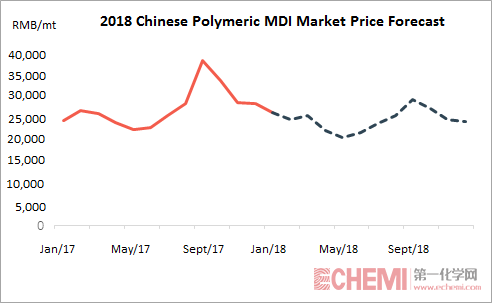
In the first three quarters in 2017, the Chinese polymeric MDI market performed actively. However, the polymeric MDI prices slumped in Q4, 2018. With the coming Spring Festival, most players had retreated from the market. Today, Echemi will forecast the overall polymeric MDI market trend in 2018. Isocyanates category
First, the supply of MDI in 2018 will increase slightly from 2017.
In 2018, the 240kt/a unit at Shanghai Lianheng Isocyanate (144kt/a capacity of polymeric MDI) is expected to be put into operation in March. Moreover, the 400kt/a unit at Sadara runs normally, and around 40%-50% goods will flow into China. The overall supply structure of polymeric MDI will change in 2018. In 2018, major suppliers are: Wanhua Chemical, BASF, Covestro, Huntsman and Sadara. The competition will be fierce.
Second, the downstream demand will remain modest.
In 2018, the downstream industries will remain weak. The refrigerator industry saw high prices of raw materials in 2017. The overall operating rate in 2018 will be fine and increase according to the expected. Supported by related policies, the external wall insulation industry will increase stably.
Third, production cost has limited influence on the MDI market.
According to Echemi’s Regression Analysis Model, the R value of polymeric MDI and benzene, polymeric MDI and aniline is 0.03 and 0.13 respectively. The P value is less than 0.05. Benzene and aniline prices have limited influence on the polymeric MDI market.
Finally, off-season and peak seasons influence the market.
Q1 is the traditional off-season and market prices will decline. In Q2, influenced by the busy farm season, it is difficult for the polymeric MDI market to move up. Q3 is the traditional peak season. Refrigerator, heat preservation industries will be good, which will promote the polymeric MDI market. In Q4, the market will enter the downtrend again.
According to Echemi, the polymeric MDI market in 2018 cannot copy the high levels in 2017 and the overall prices won’t be too low. The market prices will be in the range of RMB 20,0000-28,500/mt in cash. Lowest prices may appear in May and the highest price may appear in September.
Echemi - Chinese Pentaerythritol Market Inched Down in Feb 2018
Echemi Market review: In February, the dealing prices for 95% pentaerythritol were quiet. Raw materials prices moved marginally, and the support to pentaerythritol was weak. Influenced by the traditional Spring Festival, upstream and downstream users retreated from the market. Up to February 28, delivered prices for 95% pentaerythritol in East China were in the range of RMB 11,600-12,300/mt. Mainstream prices for 98% pentaerythritol were in the range of RMB 12,500-13,500/mt. Prices for 99% pentaerythritol were in the range of RMB 13,500-14,000/mt.

Forecast: Prices of raw materials decline recently and the effect on the pentaerythritol market is not obvious. In March, the raw materials won’t support the pentaerythritol market. Downstream users come back the market gradually, and they will mainly consume inventories stocked before. The demand for pentaerythritol will be weak. On the whole, the Chinese pentaerythritol market will continue to inch down.
more prodcuts : Polyhydric Alcohols
Thursday, March 1, 2018
2015-2017 China Butyl Acrylate Export Analysis
Introduction:
From 2015-2017, the total export volume of butyl acrylate increased obviously. According to the figure below, in 2017, the butyl acrylate export volume was 135,754mt, which was up 110% from 64,071mt in 2016. The average export price of butyl acrylate increased 30.6% Y-O-Y. Compared with butyl acrylate export in 2015, the average price changed a little, while the export volume of butyl acrylate doubled in 2017.
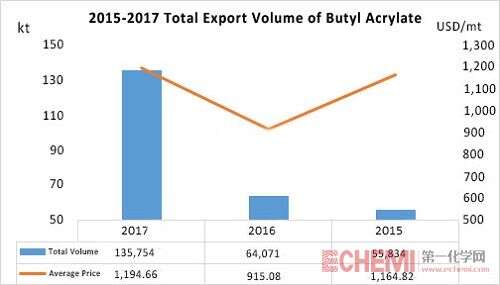
According to customs data in figure below, the export volume of butyl acrylate increased obviously in most of customs. The export volume in Nanjing Custom increased the most. According to the data, the export volume in Nanjing Custom was 53kt, and the volume was only 23kt in 2016, which was up 130% Y-O-Y. Furthermore, the export volumes of butyl acrylate in Guangzhou and Qingdao Customs increased significantly as well.
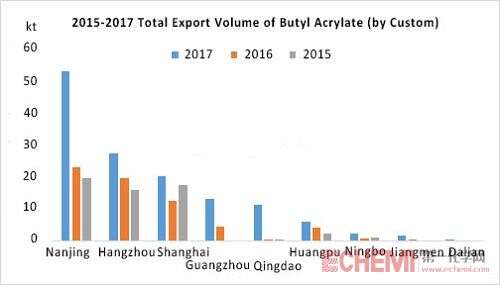
According to the form below, in 2015 and 2016, only the export volumes of butyl acrylate in Nanjing, Hangzhou and Shanghai were over 10kt. Furthermore, in 2017, the export volumes in Guangzhou and Qingdao increased over 10kt as well.
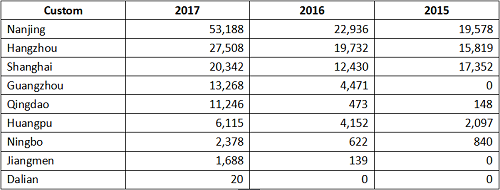
According to the figure below, the export volume in mainstream factories increased significantly. The export volume in Satlpec was the most (48kt), which accounted for 35% of total export volume in 2017. The next ranking was Shengke Chemical. The export volume increased from 8,819mt in 2016 to 25,824mt in 2017, which was up 193% Y-O-Y. Furthermore, the export volumes of BASF-YPC Company and Wanhua Group increased dramatically. In butyl acrylate export market, there are three mainstream export companies in East China, which are Satlpec, Shengke Chemical and BASF-YPC. Wanhua is the major company in North China, and Jiangmen Qianxin is the major company in South China.
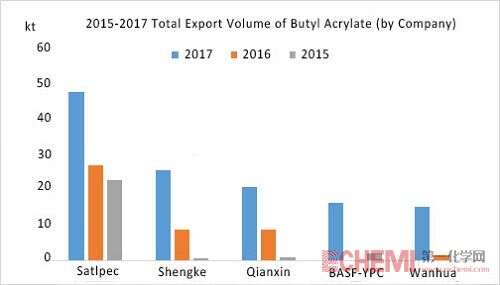

In general, as the export volume in mainstream companies increased significantly in 2017, the total export volume of butyl acrylate followed in 2017. The units were shut unexpectedly or became deteriorated in foreign companies, which provided more opportunities for Chinese butyl acrylate companies. It is predicted that the Chinese butyl acrylate price and output will become more and more important in international market.
Subscribe to:
Comments (Atom)